Queer. Black. Woman. Nonbinary. Masculine. Feminine. Those are all parts of myself that I’ve embodied throughout my life but could never fully grasp at once.
Most of the time, they felt like pieces that I should pick up, put down, shift, express or hide in order to show up as a version of myself that people around me could easily digest. It took me years to come out as queer to my strict, religious, Haitian mother out of fear of rejection. I secretly started experimenting with dapper masculine clothing during college but came home on weekends and wore dresses she bought as I accompanied her to church services.
I finally found the courage to come out to my mom after graduation when I moved to New York City. I moved in with my partner at the time and started blogging about fashion and gender identity — but couldn’t figure out what I would wear to work as a budding human resources professional.
As an HR student, I had learned that dress codes are often used as a way of maintaining a standard level of visual professionalism. But I also knew how much sexism, anti-blackness and repression of gender identities outside of cisgender-heteronormative standards are woven into many of these policies.

Bringing my full self to work would mean being the only black, masculine-presenting woman in my office, who wore button downs, vests and slacks. I was a wrench thrown in the master’s plan, and I had to be prepared for what could come my way because of it. I saw it in the subtle ways that I was treated when my hair was long and straightened versus natural, kinky and tapered. My co-workers lit up every time they saw my straightened hair. The more relatable and “professional” my appearance was to my white counterparts, the more opportunities I got.
I noticed this cluelessness and inability to assess the deeper context of what it means to be inclusive again when I embraced my dapper style at work. A supervisor of mine clumsily changed the dress code policy to be more inclusive of gender neutral and masculine clothing options for women, but failed to include any feminine clothing or accessories for any men, nonbinary folk or trans-women that would need them.
Stories like mine aren’t outliers and have sparked law changes like the Crown Act, which aims to protect black employees and students from hair discrimination in California. And most recently, plaintiff Aimee Stephens has been at the center of a Supreme Court case after she was fired for coming out as a trans woman at work. The decision will be pivotal for members of the LGBTQ community who are disadvantaged for not wanting to — or not having the luxury of — blending in.
I talked to seven queer folks on how they’ve shown up as their full selves at work and what they’ve navigated because of it.
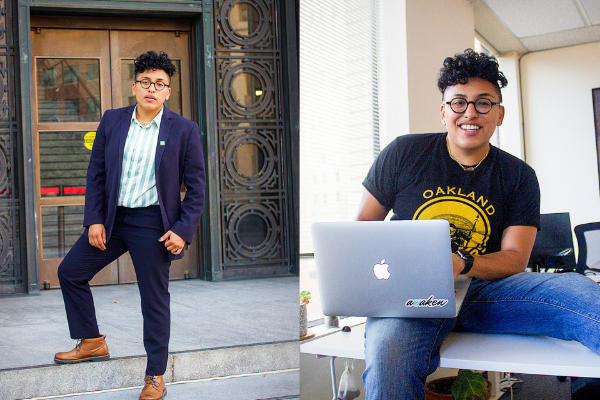
Kay Martinez
Pronouns and gender identity: they/them/theirs, gender non-conforming
Age: 34
Current occupation: Facilitator and content creator, Awaken, a firm that consults on diversity, equity and inclusion matters
I love wearing suits when I lead presentations for clients, but it’s not required. I do it for myself. Having tailored suits helps me when I’m struggling with gender dysmorphia because my clothes are made to fit my body. On days that I dress down I’m usually in a T-shirt, jeans and a pair of sneakers. I tie this all together with my mom’s gold nameplate that never leaves my neck. It says “Cecibel,” which is her given name. She changed it when she became a naturalized U.S. citizen, so I keep it to remind myself where I come from and to resist assimilation.
“I’d never felt like my gender identity and expression were truly respected or empowered in any workplace.”
Prior to my current role as a consultant with Awaken, I’d never felt like my gender identity and expression were truly respected or empowered in any workplace. My style is “androgynous,” meaning that it’s a combination of what people consider traditionally masculine and feminine. While it’s passé, I’m a “cross-dresser” in that I wear clothes from across the store, which often comes with consequences.
Any negative issues I’ve had in the workplace regarding my gender are remnants of gender policing and enforcing a gender binary. I’ve often been misgendered and questioned or feared — sometimes to the point of threats to call the police in “women’s” bathrooms. Additionally, the combination of my gender variant clothing, pronoun usage, age and high-level job has resulted in folks questioning my authority and credentials. People have policed my tone of voice, saying it’s too aggressive or “not feminine enough.” I’m glad that I work for Awaken’s CEO, Michelle Kim, a queer woman who created a trans-inclusive workplace and really does the work to educate herself on current social issues.
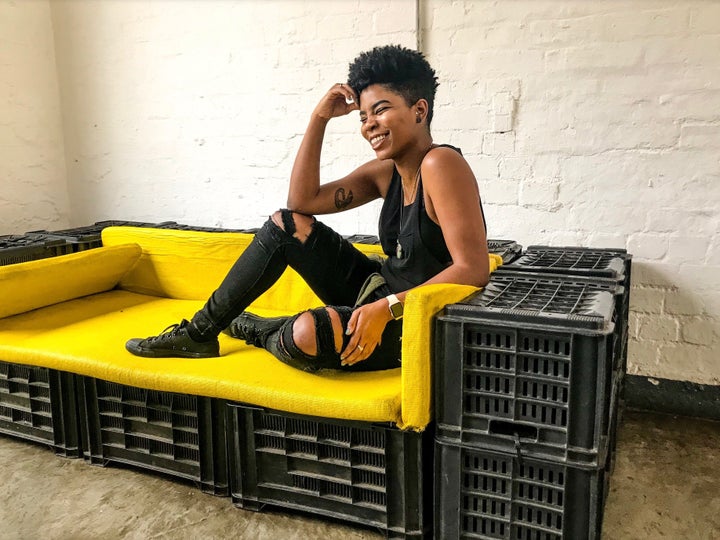
Trent
Pronouns and gender identity: she/her/they/them, gender non-conforming/gender nonbinary
Age: 32
Current occupation: Flight attendant on a major airline. (We’ve omitted a photo of Trent in their flight attendant uniform for confidentiality reasons.)
When I first began working for the airline, I wore the female-assigned uniform kit. I stuck with the more gender neutral pieces ― pants, collared shirt or turtleneck, vest and blazer ― and chose not to wear the dress option.
Recently, when the airline did a complete overhaul and changed over to a new uniform, I wasn’t satisfied. The pieces in the new uniform were meant to look definitively more feminine than before. One of the blazers and sweater were both peplum styled. The new button-up had a fly-away leaflet collar and the vests were short fitting. On our first day wearing the new uniform, someone showed me a picture of another plane crew and I noticed a female-bodied person wearing the male uniform. Up until that point, I had no idea that was an option.
I emailed my supervisor to inform him that I wanted to swap my uniform from the female kit to the male kit. I was directed to a link on our company website to fill out a “uniform exception request” form for approval. However, the link on the website was dead. It took two weeks to get a working link — and then I was shuffled between my supervisor, our uniforms department, our distributor and our accommodations department for two months until I was finally able to get approved for the male uniform.
One male-bodied person has asked me, “So are you wearing that for attention?” Another said, “I think it’s unfair that females get to order the male uniform because it’s putting all my sizes on back order.” Many of my co-workers make it a point to tell me I look good in it, which I don’t mind, but I know I get more attention than I would if I wore the female-assigned uniform. But I just wanted to wear something that felt comfortable and true to me.
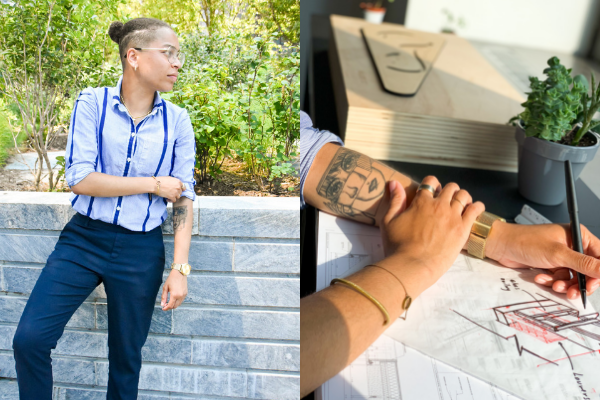
Lindsay Dawning
Pronouns: they/them
Age: 28
Current occupation: Architect and engineer
I wear patterned button-ups with cuffed sleeves, chinos and all gold jewelry to work. If I’m feeling super fly, I break out a pair of kicks. My alternative are Oxfords to go for a more classic look.
As a designer, I like clean, simple lines and my style is an extension of my design aesthetic. I design and build habitable living spaces for communities. After I water and sing to my plants in the morning, you can find me sketching my ideas with my drafting pens.
I’ve transitioned from feminine presenting to masculine presenting over the five and a half years I’ve worked at my company. I’ve had issues with cis white men in my office still trying to sexualize me or calling out my “feminine” features. I also often find my co-workers trying to connect with me through race. They tend to bring up the one black friend they have, as if our experiences are monolithic. People closer to my age are more aware of my gender so they make space for me and I’m able to feel seen. For example, they call me “plant dad” and that alone affirms me professionally.
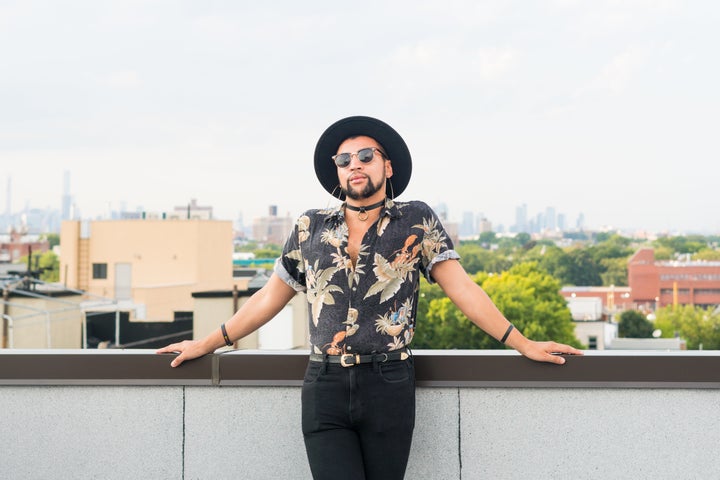
Richard
Pronouns and gender Identity: she/they/he (most folks just use “they”), genderfluid femme/transfemme
Age: 25
Current occupation: Ph.D. candidate in critical social-personality psychology at the CUNY Graduate Center and professor at the City College of New York.
One day, I received an email from HR that warned me that shorts were against the dress code. I asked for a copy of it but my request went ignored. The next week, I came in wearing jeans, a short-sleeve button-up, hoop earrings and lip gloss. I received another email from HR stating that the hoops and lip gloss were also against the dress code. I again demanded that they send me the dress code. I got the 125-page employee manual and sifted through it to find “shorts” listed among other unacceptable clothing like “mesh T-shirts,” “ripped jeans,” “spandex” and “gang-affiliated attire.” The rest of the dress code used vague and classist language like “respectable clothing.”
“I looked around the office and noticed many cis women wearing hoops and lip gloss. It was then that I knew that this wasn’t about anything I did, it was discrimination hidden behind a vaguely worded dress code.”
I looked around the office and noticed many cis women wearing hoops and lip gloss. It was then that I knew that this wasn’t about anything I did, it was discrimination hidden behind a vaguely worded dress code. Through its actions, this organization decided that because I was perceived as a “man,” I shouldn’t be wearing certain things, and it used the language of “professionalism” to enforce its own biases.
I never stopped wearing my hoops and lip gloss. HR stopped emailing, but decided to send emails to my supervisors — who thankfully had my back — about how “unreasonable” and “unprofessional” I was. At the end of my fellowship, I gave a presentation where I read the organization for filth in the most “professional” way possible. The situation made me feel powerless and unwanted; I was furious at the amount of labor I provided them. I don’t often fit the mold of what people expect a student to look like, let alone a professor — which means I have to flex my knowledge, qualifications and capabilities much more often than folks who “fit in” better.
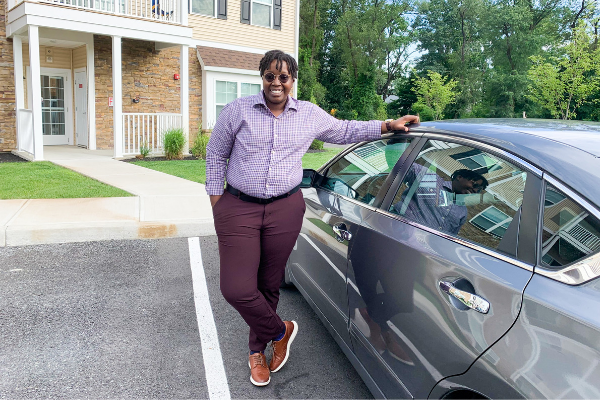
Phylicia Coley
Pronouns: she/hers/her
Age: 27
Current occupation: Associate dean at a higher education institution
Typical items I wear to work include slacks, button-ups, sweaters, business casual sneakers, dress shoes and work bags.
A few years ago, while interning, I was asked if I could dress more appropriately for a specific event that would be attended by alumni and donors. It was suggested that I not wear a bow tie or traditional tie if possible.
At an earlier job, we had a tradition of dressing down on Fridays to show school spirit. On one specific day, I decided to wear open-toed shoes due to the weather. My colleague at the time, who presumed we were work friends, commented, “Oh, your toes are painted? Look at you being the girly girl.”
All of this made me more committed to my profession, simply because students who identify with me may need someone who they can confide in for support. They see me as a representation of themselves and as an advocate for their identities. Students tend to engage in my programming and office initiatives due to how I present and carry myself around campus.

Stephanie Cadet
Pronouns: they/them, she/her
Age: 30
Current occupation: Mental health therapist and supervisor of care coordination at a nonprofit that serves local youth.
I wear patterned or pleated pants, T-shirts with the sleeves rolled, sneakers or Oxfords. I accessorize with jewelry, watches, a half-sleeve of tattoos and a few other smaller tattoos. On a day-to-day basis, I provide therapy sessions, handle crisis situations and connect young people to services and resources.
“I just remember feeling embarrassment and shame.”
I was interning at a predominantly white middle school in New Jersey and was already uncomfortable ― I wore slacks, boat shoes and a button-up. All were a size too big since I hadn’t figured out my style and I was self-conscious because I just started exploring my masculinity. One day my supervisor called me into her office and proceeded to tell me that I was dressing too casually and unprofessionally. I don’t remember how I responded or what happened moving forward. I just remember feeling embarrassment and shame.
After that, I was conscious of where I applied to work and made sure they were casual work environments that were comfortable with a range of gender expressions. I specifically looked for places that had a known queer culture, which limited the spaces that I felt safe to consider for employment.
In college, I considered going the MBA route, but knew I’d feel uncomfortable for various reasons (whiteness, toxic masculinity, heteronormativity). So I decided to pursue counseling, for what I perceived to be the more laid-back atmosphere. I hope to show anyone I work with who is queer or doesn’t fit Eurocentric standards that it’s possible to show up authentically as your full self.

Vanessa Aviva
Pronouns: she/her/hers
Age: 25
Current Occupation: Associate Director of LGBTQ Outreach at Columbia University
Columbia is more on the professional side in terms of dress codes. There are a lot of younger professionals, so it’s not a suit-and-tie environment but it is definitely a step up from business casual. What I wear is dependent on what my calendar looks like that day. If I am doing a presentation or running a workshop or training, I’ll wear a dress and heels or a blazer. If I am meeting with a dean, an associate vice president or someone at a higher level than I am, I try my best to look as professional as possible. If my meetings are mostly with students or not as high level, I wear slacks with a nice shirt tucked in and some work/dress shoes.
Something that has definitely been a pattern for me is that people’s own biases come out when speaking with me. Being a trans woman that passes as both cis and white, folks often see me as a “safe” trans person. Beyond my general job doing queer and trans inclusion work, there are instances where people start talking to me in random places (in the bathroom or elevator; waiting in line at a coffee shop) about their random gender thoughts and problematic things they have done or think they are doing. It’s honestly very exhausting; oftentimes I do not have the bandwidth to actually engage or interact in those conversations. In all of these instances, it’s clear that these cis folks’ are more comfortable around those of us who can pass.
These interviews have been edited for clarity and length.
